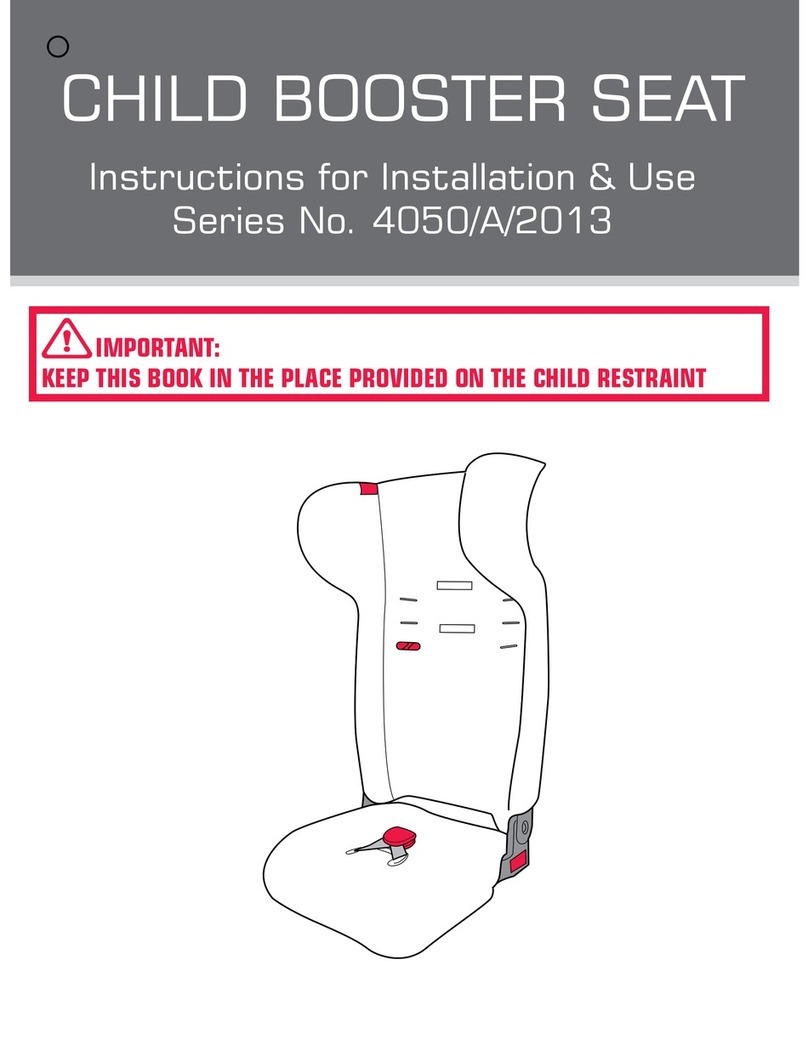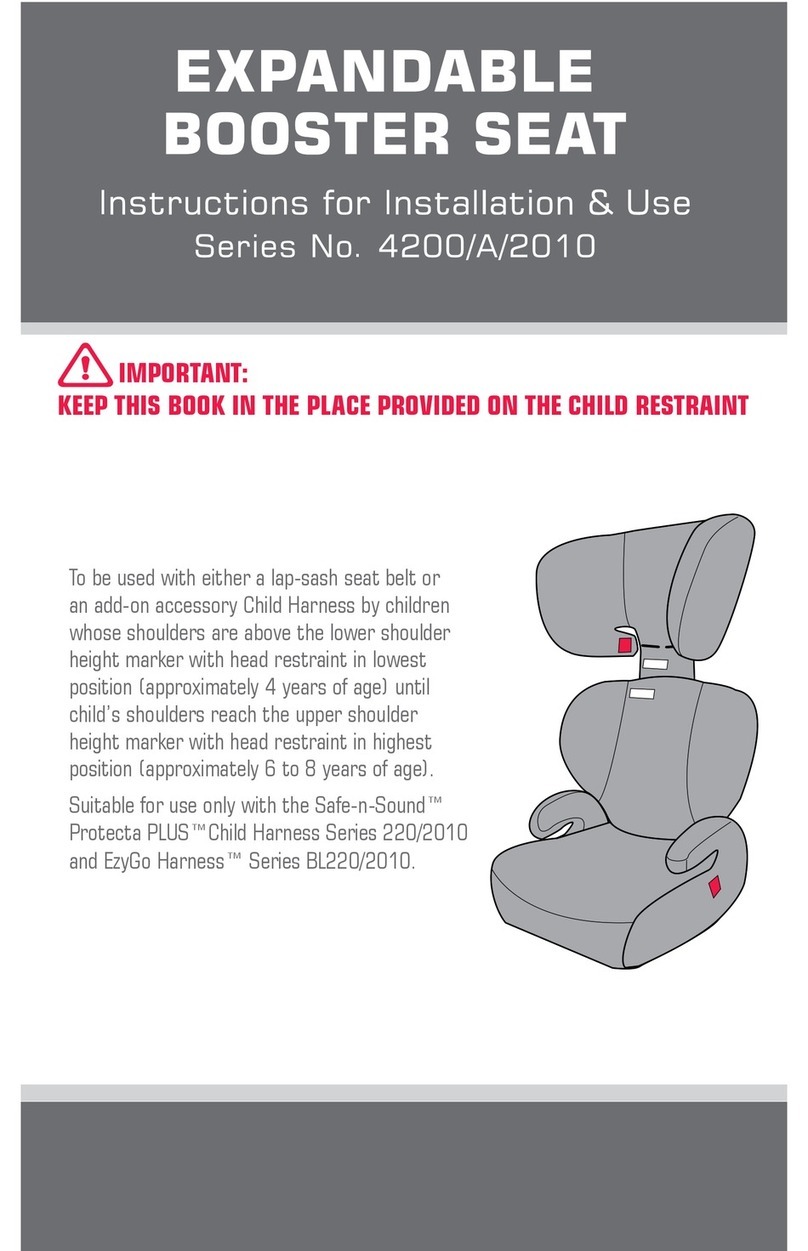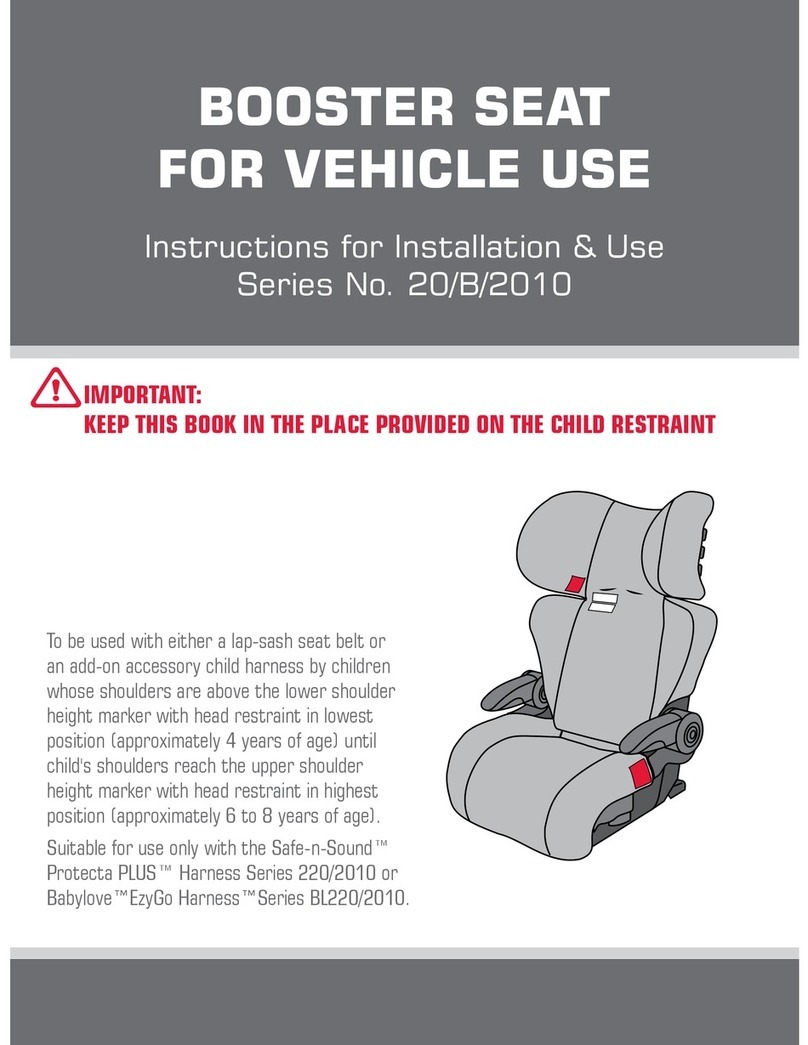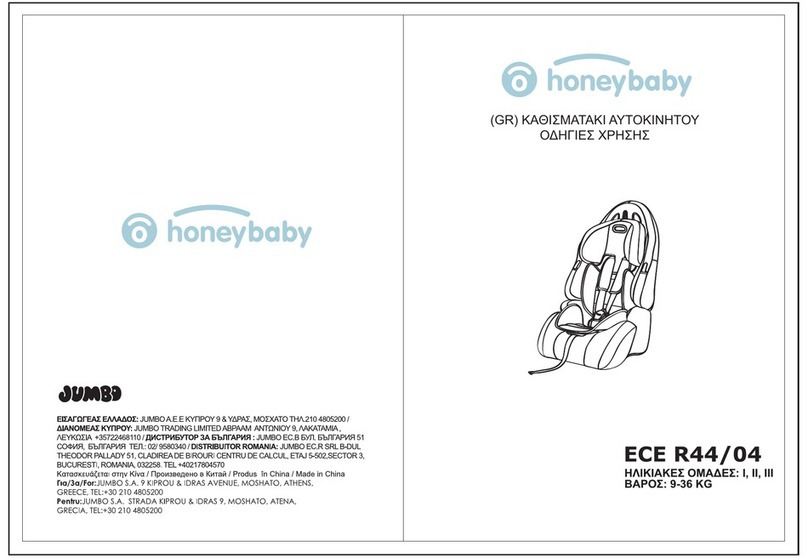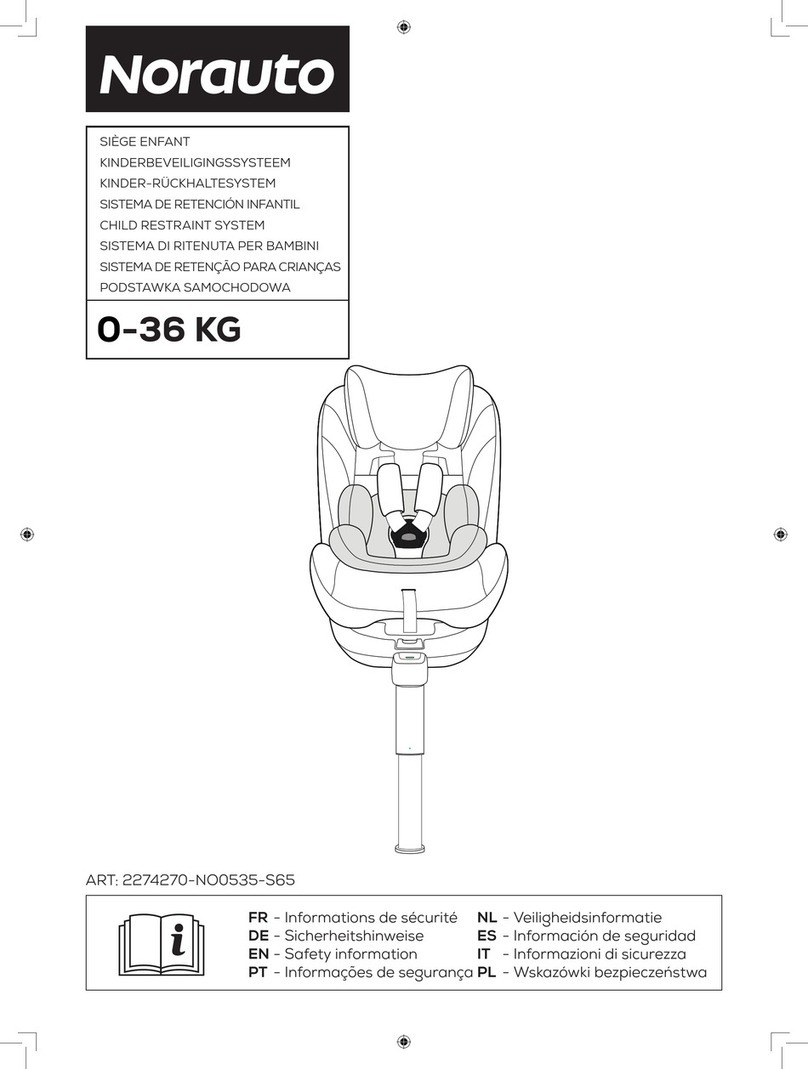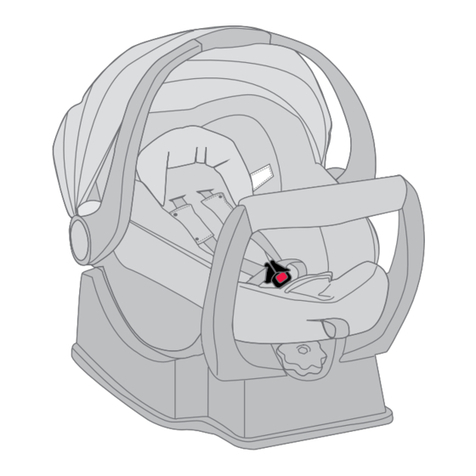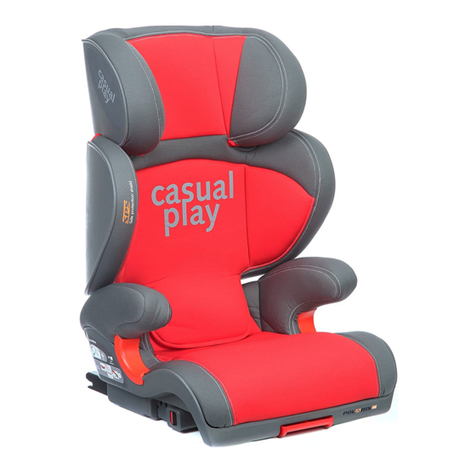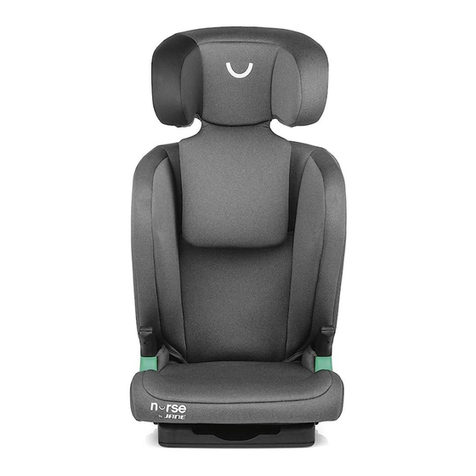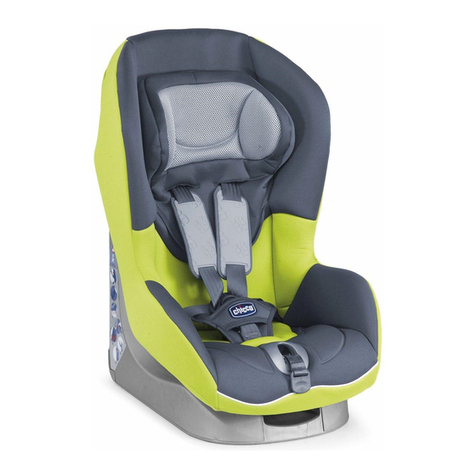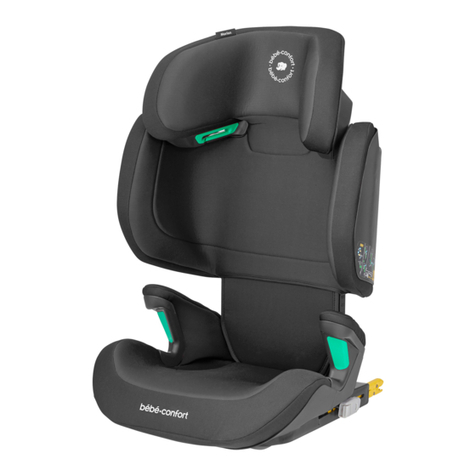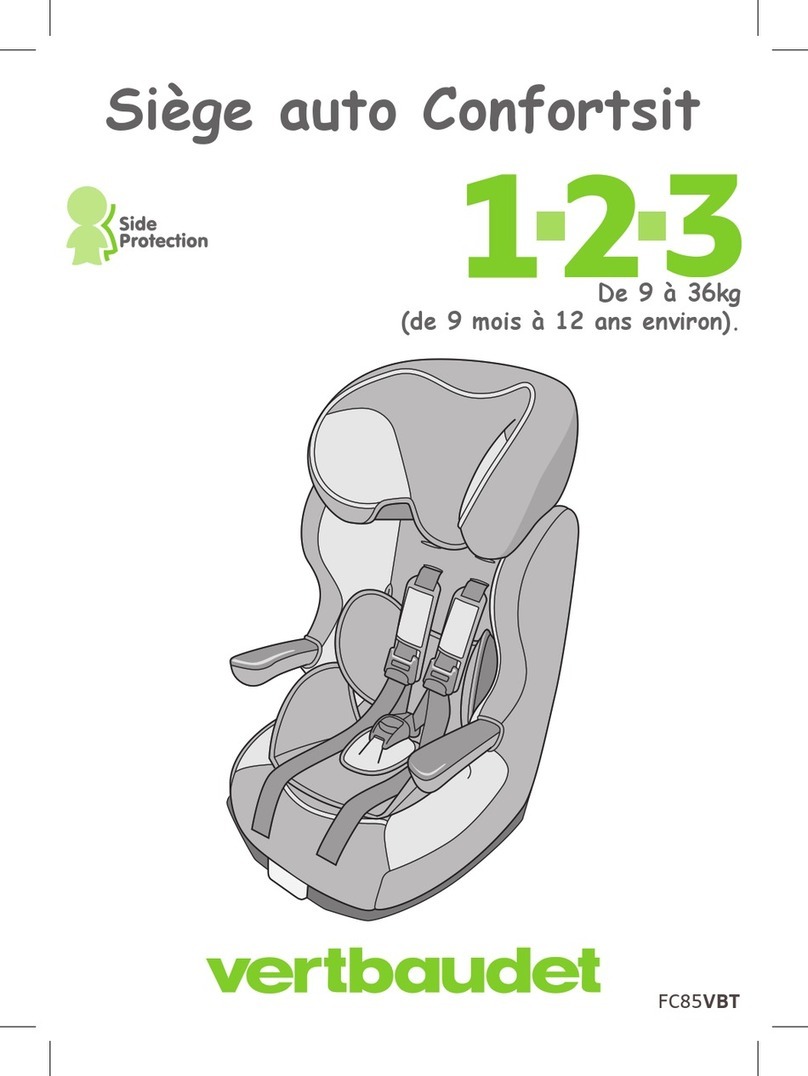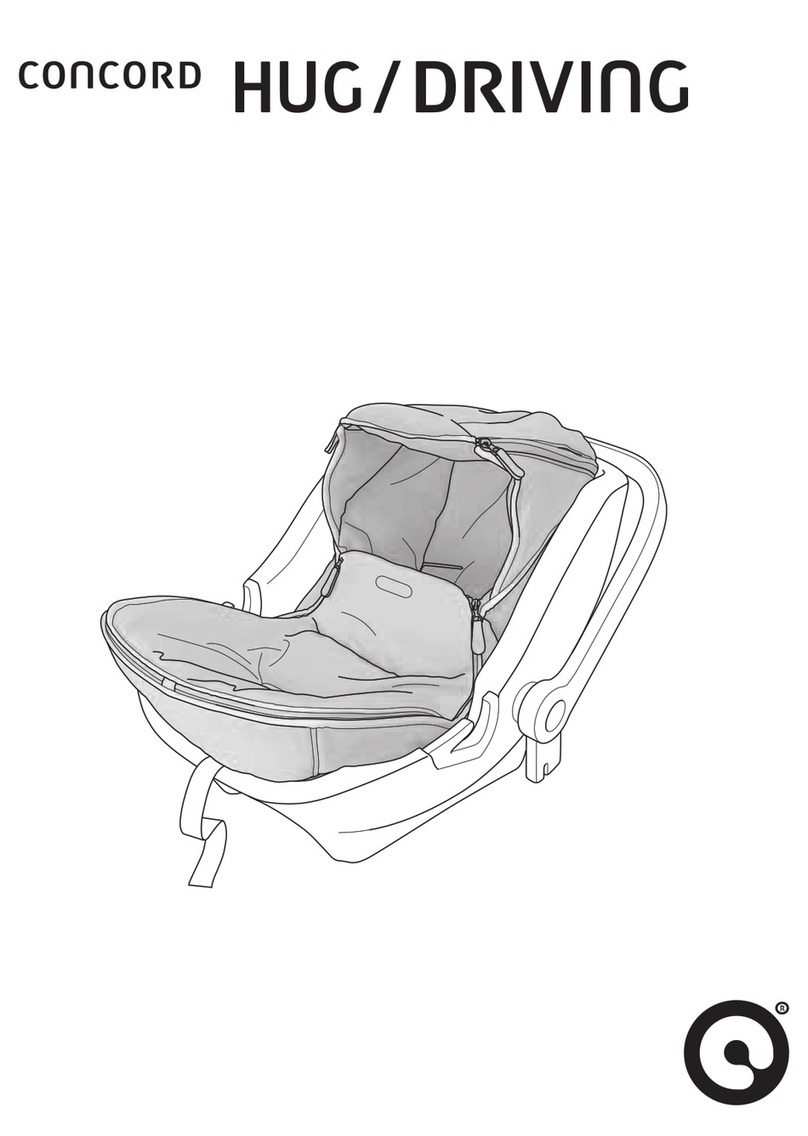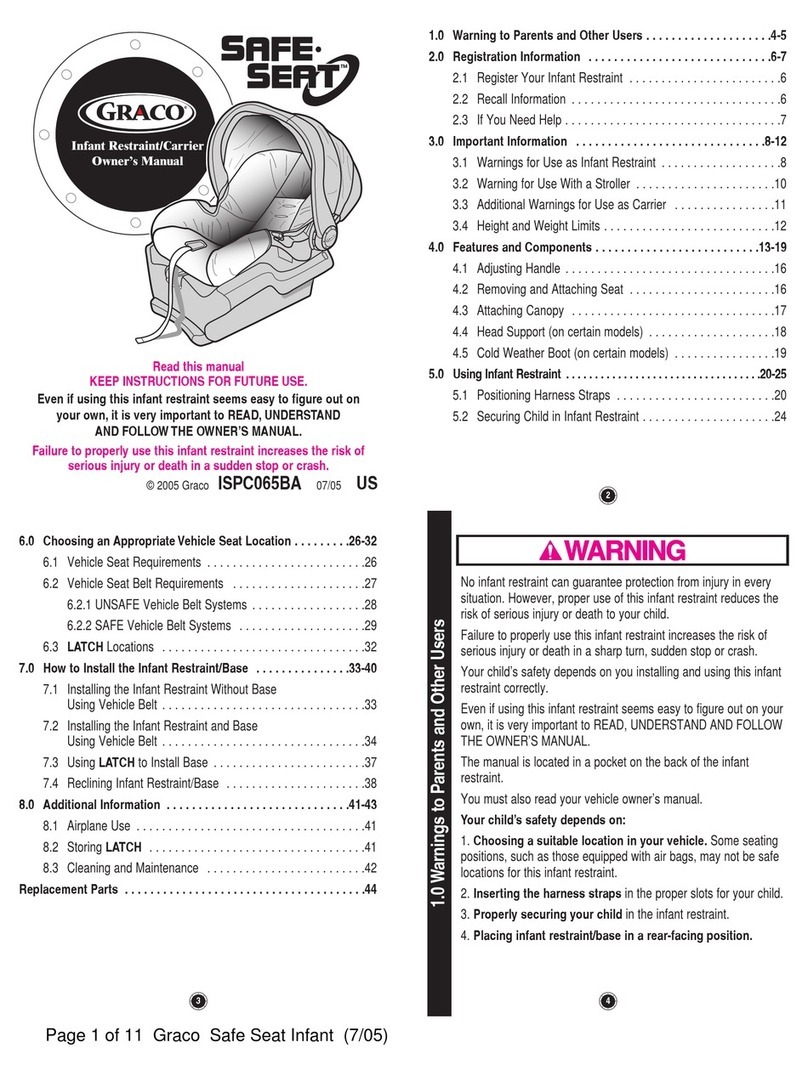Next generation 10/D/2010 User manual

Forward Facing - Toddler Use
For children approximately 6 months to
approximately 4 years of age, using the
in-built harness.
Forward Facing - Booster Seat Modes
For children approximately 4 years of age to approximately 6
to 8 years of age when used as a booster seat with lap-sash
seat belt or child harness and seat belt. (A child harness
must be used in a position with a lap only seat belt).
Suitable for use only with the following child harnesses:
Safe-n-Sound™Protecta PLUS™Harness Series 220/2010
or Babylove EzyGo Harness™ Series BL220/2010.
IMPORTANT: KEEP THIS BOOKLET IN THE PLACE PROVIDED ON THE CHILD RESTRAINT

INTRODUCTION
2
INDEX
3
The child restraint is suitable for toddlers and older children as a convertible booster seat. This child restraint is
tted with our exclusive VERSATETHER
™
catch that allows it to use the Safe-n-Sound Protecta
PLUS™
child harness
or Babylove EzyGo
™
child harness in booster seat mode for older children.
To be used in forward-facing position with in-built harness by children whose shoulders are above the lower
shoulder height marker (approximately 6 months of age) until their shoulders reach the middle shoulder
height marker (approximately 4 years of age). Then to be used with either a lap-sash seatbelt or an add-on
accessory child harness until their shoulders reach the upper shoulder height marker (approximately 6 to 8
years of age).
Continue to use this child restraint until the child reaches this limit. Children are safest in a booster seat until
their shoulders reach the upper shoulder height marker of the booster seat.
Do not use this restraint until child’s shoulders are above the lower shoulder height marker. Just using a
seatbelt is not recommended for children that have outgrown this seat. Use a larger booster.
Only the
Safe-n-Sound™Protecta PLUS™Harness Series 220/2010 or Babylove EzyGo Harness™ Series
BL220/2010 Child Harnesses
are suitable for use with this product. No other child harness is suitable unless
recommended by Next Generation Nursery Products Pty. Ltd.
WHEN USED WITH IN-BUILT HARNESS- TO BE USED WITH A LAP-SASH OR LAP ONLY SEAT BELT IN THE BACK OF
MOST CARS WITH FORWARD FACING SEATS.
WHEN USED AS A BOOSTER SEAT- THIS RESTRAINT MUST BE USED IN CARS WITH FORWARD FACING SEATS WITH A
LAP-SASH SEAT BELT OR WITH A SEAT BELT AND CHILD HARNESS. When using a child harness with the seat it may be
used in seating positions with either a lap or lap-sash seat belt which are tted with a child restraint anchor tting.
THIS BOOSTER SEAT MAY ONLY BE SUITABLE FOR USE WITH A CHILD HARNESS IN THE UPRIGHT POSITION. IN THE
RECLINE POSITION, THE CAR'S SEATBELT MAY NOT BE LONG ENOUGH.
When used with a lap-sash seat belt the Booster Seat mode may only be suitable for use in upright position as the
car's seatbelt may not be long enough for use in the reclined position.
No child restraint can guarantee absolute protection from injury in every crash. However, to ensure that your child
gets all the protection designed into the restraint PLEASE READ AND FOLLOW THESE INSTRUCTIONS EXACTLY and use
only parts and accessories recommended by Next Generation Nursery Products Pty. Ltd.
Carefully read all the instructions for installation in this book. If in doubt about the method of installation, consult
Next Generation Nursery Products Pty. Ltd. or agent or a child restraint tting station authorized by a relevant
transport authority or, in New Zealand, the agent for the vehicle or authorised child restraint tter.
THIS RESTRAINT MUST BE ATTACHED TO A CHILD RESTRAINT ANCHORAGE POINT IN THE CAR. REFER TO CAR
OWNER’S HANDBOOK FOR LOCATION OF ANCHORAGE POINTS. REFER TO A CHILD RESTRAINT FITTING STATION IF NO
ANCHORAGE POINTS ARE IN THE MOTOR CAR (REFER TO PAGES 59 TO 62).
Keep these instructions in the place provided in the pocket at the back of the cover.
Page
3 Introduction
4 Warnings
6Shoulder height markers & a growing child
8Shoulder height labels & the next step
For Toddler Use: With in-built harness
10 Special Features - Toddler Restraint
12 Suitable for use / Warnings
13 How to set-up
19 How to install
23 How to use
For Child Use: Booster Seat Modes
26 Special Features - Child Booster
28 Suitable for use / Warnings
29 How to set-up
35 How to use with lap-sash seat belt
39 How to install with a child harness
General Instructions
54 Care & maintenance
55 How to clean
57 Accessories & features
59 Pre-installation anchor tting
63 Precautions

WHEN USED WITH THE 'IN-BUILT ' HARNESS
• Fit the restraint rmly to the car.
• Fit the harness rmly to the child.
• A loose restraint or harness is dangerous.
• When used in this mode the restraint must be used in conjunction with a lap or lap-sash seat belt.
AS A BOOSTER SEAT (with or without a separately supplied Child Harness)
• DO NOT USE WITH JUST A LAP BELT. You must use with a lap-sash belt or with a seat belt and child harness.
• The lap part of the seat belt must be rmly across the thighs and the sash straps tted diagonally across
the chest and on the shoulder.
• If used with a child harness, the lap strap of the seat belt must be adjusted rmly rst and then the harness,
so that the lap strap is not lifted off the child’s lap when the harness is adjusted.
• Do not use with the integral harness when in booster mode. This in-built harness must be stored.
• Use only with a lap-sash seat belt or with an add-on accessory child harness and either a lap or lap-sash
seat belt.
GENERAL WARNINGS- also see warnings on pages 12 and 28.
• Supervision of children is needed because they may be able to undo buckles and adjusters.
• Use the restraint exactly as shown in the instructions.
• DO NOT LEAVE CHILDREN UNATTENDED IN THE CAR.
• Do not alter or modify this restraint.
• Repairs must only be done by the manufacturer or agent. Use only recommended parts and accessories.
• Do not allow the restraint to come into contact with polishes, oils, bleach and other chemicals.
• Destroy the restraint if it has been in a severe crash, even if no damage is visible. See page 64.
• DO NOT USE THIS RESTRAINT WITHOUT THE COVER.
• Regularly check the restraint components, straps and other tments for correct function and condition.
Seek prompt repair.
• IF AN AIRBAG IS FITTED IN THE SEATING POSITION WHERE THE CHILD RESTRAINT IS TO BE FITTED, FOLLOW
THE VEHICLE MANUFACTURERS WARNINGS AND INSTRUCTIONS.
• Straps may be damaged by unsecured cargo in a collision. Secure or remove hazardous cargo before using
this restraint. Hatch-back or Wagon: Do not use the child restraint where this strap may fall into a split in
the seat back. Always attach hook and remove slack.
• Protect all webbing from abrasion and cutting by sharp corners and edges.
• The restraint should not be purchased or sold as a second hand item. It is recommended not to use child
restraints older than 10 years as the protection in an accident may be reduced.
• This restraint must be used in conjunction with a lap or lap-sash seat belt.
• THIS RESTRAINT IS NOT SUITABLE FOR USE WHERE THE ANCHORAGE STRAP MAY FALL INTO A SPLIT IN THE
SEAT BACK (E.G. HATCHBACK OR WAGON).
• Seat belt extenders should not be used if the seat belt is not long enough to t around the child. If a seat
belt extender is used then the seat belt buckle must not be in contact with the child.
• Do not store in areas that may get hot, like in car boots, roof space, beside shed walls which get hot in
summer. Do not place heavy items on top of the seat as this may distort the plastic
45
DO NOT LEAVE CHILDREN UNATTENDED IN THE CAR.
:

YOUNG TODDLER
Shoulders must not be below the lowest shoulder
height marker. Use the in-built harness up to the
middle marker.
From approximately 6 months of age.
AS A BOOSTER SEAT
With Lap-sash seat belt
To approximately 6-8 years of age.
OLDER CHILD
SHOULDER HEIGHT MARKERS &
A GROWING CHILD
SHOULDER HEIGHT MARKERS &
A GROWING CHILD
Marker B
Markers B and C are visible with the
headrest in the upper positions.
6 7
Marker C
Marker B
Marker A
AS A BOOSTER SEAT
With Seat Belt & Child Harness
To approximately 6-8 years of age.
Marker A
OLDER TODDLER
Shoulders inline with middle shoulder height marker.
Change to Booster Seat mode.
To approximately 4 years of age.
Shoulders above middle shoulder height marker but below upper shoulder height marker.
Change to the next type of booster seat or child restraint when shoulders reach the upper shoulder height
marker when the headrest is in the highest position.
A child harness must be used if the car’s seating position is tted with a lap only seat belt. If a child no longer
physically ts in the seat then move to the next form of child restraint.
Marker B
Marker C
Marker B
Marker C
OR
Front of Vehicle
Front of Vehicle

When your child has outgrown the seat, you can either use:
IMPORTANT: Follow this advice.
SHOULDER HEIGHT LABELS & THE NEXT STEP
SHOULDER HEIGHT LABELS & THE NEXT STEP
89
Next type of restraint that can be used in the car for your child.
Or you can use a Child Harness
and lap seat belt. Lap seat belts
can be dangerous without a
Child Harness.
Just the car's lap-sash
seatbelt.
Or you can use a narrow
booster seat suitable for
children up to 8-10 years
of age. An accessory Child
Harness may be used.
Marker A Smaller Toddler - LOWER SHOULDER HEIGHT MARKER
Marker B Larger Toddler - MIDDLE SHOULDER HEIGHT MARKER
Using the in-built harness, The
child’s shoulders must be in-line
with this marker or above this
marker. If the child’s shoulders are
below then the child should remain
in their previous child restraint.
Approximately 6 months.
When the child’s shoulders reach
this marker, convert the child
restraint to booster seat mode
and use either a lap-sash seat belt
or a child harness and lap-sash
seat belt or lap only seat belt.
Approximately 4 years.
When the child’s shoulders reach
this upper marker, or the child no
longer ts in the child restraint,
approximately 6 to 8 years of age,
then the child must be moved to
the next form of child restraint,
see next page.
Marker C Larger Child - UPPER SHOULDER HEIGHT MARKER

10
NOTE: Not all features are supplied on some models. "if supplied" is used to indicate some of the features that
may not be supplied with the seat.
To be used only in a forward-facing position with the in-built harness for a toddler whose shoulders are above
the lower shoulder height marker (approximately 6 months to 4 years of age) until the shoulders reach the
middle shoulder height marker.
Front of Vehicle
Harness
Tongues
Harness
Buckle
SPECIAL FEATURES - TODDLER RESTRAINTSPECIAL FEATURES - TODDLER RESTRAINT
Car's Anchor Fitting.
Car’s lap-sash seat belt or lap only seatbelt.
Forward Facing belt path labels (each side).
Recline Foot in upright installation.
Harness Adjustment Strap.
Harness Adjuster Lever.
Lap Belt Positioning Converter for Booster mode (shown stored under cover).
Quick release Harness Buckle (red button).
Seat belt path slot.
Shoulder Height Markers.
Adjustable Headrest (with speakers, if supplied).
Fully Adjustable 6 point harness.
Upper anchorage Strap Adjuster.
Upper Anchorage Storage Band.
Adjustable Upper Anchorage Strap.
Attachment Clip and VERSATETHER™ catch.
9
2
4
5
6
7
11
13 14 15 16
1
8
11
12
3
3
TODDLER USE: WITH IN-BUILT HARNESS
TODDLER USE: WITH IN-BUILT HARNESS
1
2
3
4
5
6
7
8
9
10
11
12
13
14
15
16
10

12 13
HOW TO SET-UP
TO BE USED WITH A LAP-SASH OR LAP ONLY SEAT BELT IN THE BACK OF MOST CARS WITH FORWARD-FACING
SEATS.
To be used in forward-facing position by children whose shoulders are above the lower shoulder height marker
(approximately 6 months of age) until their shoulders reach the upper shoulder height marker (approximately
4 years of age).
Continue to use this infant restraint until the child reaches this limit.
Do not use this restraint until the child’s shoulders are above the lower shoulder height marker.
Infants are at risk of serious injury if they face forward too early.
Children are at risk of serious injury if they move to booster seats too early.
The child should not sit in this forward facing child restraint until their neck muscles are able to support their
head. Stay in a rear facing child restraint.
Regional Road Rules may prohibit the use of this restraint in the front seat until the child is 4 years of age.
Check your Regional Rules for exemptions.
• Fit the restraint rmly to the car seat and then t the harness rmly to the child.
• A loose restraint or harness is dangerous.
• Do not use in a front seat, unless it has a child restraint anchorage point and your child is over 4 years of
age or in accordance with the applicable Road Rules in your region.
• Do not use the restraint without the Upper Anchorage Strap correctly attached.
• Do not use on any vehicle seat which faces sideways or rearwards.
• WHERE AN AIRBAG IS FITTED IN THE SEATING POSITION WHERE THE CHILD RESTRAINT IS TO BE FITTED,
FOLLOW THE VEHICLE MANUFACTURERS WARNINGS AND INSTRUCTIONS.
• IMPORTANT: Use lap or lap-sash seat belt and upper anchorage strap to attach the child restraint to the
vehicle seat.
• Ensure that the Lap Belt Positioning Clip is stored in the recess under the cover when the seat is used in
Toddler mode, so as to avoid injury or discomfort.
SUITABLE FOR USE
INSTALLATION AND USE OF RESTRAINT
For Toddlers who have reached the shoulder height limit on their infant restraint refer to pages
10-25. For Children who have reached the middle shoulder height marker and need to use a
booster seat refer to pages 26-53.
HARNESS ADJUSTMENT
To slacken the harness lift the harness adjuster lever
and pull both shoulder straps with the other hand.
HOW TO USE THE HEADREST
First remove both harness straps (Refer to page 16).
Then rotate lever down to loosen headrest clamp (a).
Slide the headrest up or down to suit the height of your
child, (refer to page 14 for toddler use or page 32 for
child use). In toddler mode, move the headrest so that
the bottom slots in the headrest line up with the top of
the child's shoulders. Then move the headrest so that
the slots line up with the nearest slots in the shell.
Ensure that the shoulder slots are correctly aligned
with the shoulders otherwise, move up to the next set
of slots in the shell. Rotate the lever upward to tighten
the headrest clamp (b). Then ret both harness straps,
ensuring that there are no twists and that each strap
is in the correct and matching slots in both the seat
shell and headrest (Refer to page 17).
UPPER ANCHORAGE
There needs to be an anchor tting in the car behind the desired
seating position. Refer to your car owner’s manual for the
location of the anchor tting. If the car is not tted with a child
restraint anchor tting then refer to page 59 for the installation
of the anchor tting provided with this child restraint.
(a) To Release
Attachment Clip (hook)
Car's Anchor Fitting
(b) To Lock
Pull Straps
Lift and hold Harness
Adjuster lever up
TODDLER USE: WITH IN-BUILT HARNESS
TODDLER USE: WITH IN-BUILT HARNESS

14 15
HOW TO SET-UP
HOW TO SET-UP
ADJUSTING HARNESS STRAP HEIGHT & HEADREST:
Correct tment of the harness is very important as it restrains the child in the restraint. The harness must t
rmly around the upper torso of the child and be positioned so as to leave the child's arms and legs free.
FOR TODDLER USE:
The shoulder straps must be in the slots which are nearest
to the child’s shoulders, but not more than 25mm below the
child's shoulders. If shoulders are above the middle shoulder
height marker then the child is too large for toddler use with
the in-built harness and the restraint must then be converted
for child use as a booster seat. (Booster Seat Mode - see
pages 26 onwards).
Note: If child’s shoulders touch the headrest side wings,
Raise the headrest to the next shoulder strap position. Typically
slots (1), (2) and (3) will be used with the in-built harness.
IMPORTANT:
You must adjust the crotch strap to the correct length for your child before installing the restraint as it cannot
be adjusted in the car. The crotch strap should only be extended if the harness tongues are located low against
your child's legs, thus creating discomfort.
The buckle should always be positioned low down on your child's body.
DO NOT attempt to remove the crotch strap from the adjuster. Adjustment is made by feeding the crotch strap
through the adjuster as shown and does not need to be removed from the seat.
SETTING UP THE HARNESS
A. Sit the restraint against a wall for stability and get the child to sit
comfortably in position.
B. Determine the desired headrest and shoulder strap position as
described on pages 13 and 14.
C. Remove the child and adjust the buckle strap and shoulder straps
using the following methods.
D. Conrm the correct set-up of the in-built harness, and repeat
steps A, B and C if required.
Adjusting the Crotch Buckle Height
Seats are tted with an adjustable length crotch strap where
the webbing needs to be threaded through a 3 bar adjuster
plate, as follows;
A. Locate the crotch strap adjuster under the seat (turn seat
upside down).
B. To change the length of the crotch strap, thread through the
adjuster in the direction of the arrows shown and remove any slack.
C. Adjust the crotch buckle to the correct position for your child.
With the centre of the buckle button level with the top of the child's
thighs, the buckle is in an ideal position. Ensure that the harness
tongues do not push into your child's thighs as this will cause
discomfort.
D. Check the buckle position on the child after adjustment.
Lengthen
Shorten
Centre of
button on
buckle, level
with top of
child's thighs
(with all slack
removed from
crotch strap.)
Buckle
Position
OK
1. Lower shoulder strap slots.
2. Mid shoulder strap slots.
3. Upper shoulder strap slots.
4. Top slots in seat back
5. Bottom slots in headrest
6. Top slots in headrest.
7. Headrest clamp.
8. Shoulder harness straps.
9. Harness tongues & buckle.
10. Lap strap slots.
11. Crotch strap slots.
12. Harness adjustment strap.
13. Shoulder Height Markers. Rear view of Child Restraint
6
5
88
9
10 10
11 11
13
12
1 1
2 2
3 3
4 4
7
TODDLER USE: WITH IN-BUILT HARNESS
TODDLER USE: WITH IN-BUILT HARNESS
25mm

(b) To Lock
STEPS IN CHANGING SHOULDER STRAP SLOTS
A. Remove the restraint from vehicle.
B. Turn the seat upside down and
locate the connection of the
harness strap. Pull 3-Bar Slide
away from 2-Bar Slide then turn
the 3-Bar Slide and push through
2-Bar Slide as shown right.
C. Feed 3-Bar Slide through Lap Strap
slot in restraint & cover.
D. Push Harness Tongue and 3-Bar
Slide through shoulder strap slot at
the front of the headrest.
1716
HOW TO SET-UP HOW TO SET-UP
2-Bar Slide
Pull 3-Bar
slide
Push and turn
3-Bar slide
through 2-Bar
slide
2-Bar Slide
F. Insert shoulder straps through the lower headrest
slots which will position shoulder strap level with or
above the child’s shoulders, as shown right. Ensure
that the Shoulder strap passes through matching slots
in the restraint.
Only use the lower set of slots in the headrest for the
in-built harness, the top slots in the headrest are only
for use with the Child Harness (See pages 39 to 53).
Insert nger above the webbing to
ensure shoulder slots in headrest
and restraint match up.
Harness
Shoulder Straps
Locked
Unlocked
(a) To Release
E. To release the headrest, go to the back of the
restraint and rotate lever down to loosen headrest
clamp. Slide the headrest up or down to suit
the height of your child (see pages 13 and 14).
Ensure that the headrest slots match up with the
corresponding slots of the restraint body. Then,
rotate the lever upward to lock the headrest clamp.
DO NOT lock the headrest in any other positions,
otherwise the slots will not align correctly.
Lap strap
slot
Pull to check connection
TODDLER USE: WITH IN-BUILT HARNESS
TODDLER USE: WITH IN-BUILT HARNESS

Re-Connect the 3-bar
slide to 2-bar slide.
Lap strap slot
(each side)
G. Insert the shoulder straps through the lap strap slots
in the cover and the restraint.
H. Ensure there are no twists in the harness strap and
the buckle tongues face the correct way.
I. Re-engage the 3-Bar slide to 2-Bar slide. Pull on straps
to ensure the slides are locked into position.
IMPORTANT:
Do not use the restraint with harness shoulder straps
set at different heights or fed through mismatching slots.
Ensure harness straps are not twisted and that all straps
are secure by pulling each harness strap.
HOW TO SET-UP HOW TO INSTALL
INSTALLING INTO VEHICLE (FORWARD FACING) (UPRIGHT OR RECLINED)
B. Determine whether an upright or reclined
installation is preferred as shown.
C. To move the Recline Foot from under restraint, lift the restraint
and swing the foot back as shown. Place back on the vehicle seat.
UPRIGHT RECLINED
Recline Foot
position
for upright
installation.
Recline Foot
position for
reclined
installation.
A. There needs to be an anchor tting in the car behind the
desired seating position. Refer to your vehicle owner’s
manual for the location of the anchor tting. If the vehicle
is not tted with a child restraint anchor tting then
refer to page 59 for the installation of the anchor tting
provided with this child restraint.
Attachment Clip (hook)
Car's Anchor
Fitting
D. Position restraint in forward facing mode and align restraint centrally to the chosen seating position and the
car's child restraint anchor tting. Some vehicle seat fabrics (particularly velours) may be damaged by a child
restraint used continuously. We recommend the use of a thick towel or other protection to keep the vehicle
seat in good condition.
1918
TODDLER USE: WITH IN-BUILT HARNESS
TODDLER USE: WITH IN-BUILT HARNESS

HOW TO INSTALLHOW TO INSTALL
2120
E. Fully lengthen lap or lap sash seat belt and insert
in through near seatbelt slot in the seat back.
Ensure the seatbelt is between the harness
straps at the back of the restraint and the
vehicle seat. From the back of the restraint, push
seatbelt out through the far seatbelt slot to the
front of the seat.
F. Engage seat belt buckle and tongue ensuring that lap part
of seat belt is within the recessed area. Push down on the
restraint and adjust the seat belt to hold the restraint rmly
against the vehicle seat by pulling on sash strap to remove
slack in lap strap. Pass the sash belt between the side of the
headrest and the side of the seat. For retractor seat belts,
allow excess belt to feed back into retractor.
NOTE: Some vehicle seats have more rearward slope than others. Use a rolled up towel or padding under the
seat for contoured vehicle seats to prevent excessive recline.
Upper
Anchorage
strap
Sash belt
Seat belt
on the
outside of
the harness
straps
Lap belt
Sash belt
Near Seat
belt Slot
Yellow marker identies
FORWARD FACING
BELT PATH
Far Seat
belt Slot
G. Fully press Upper Anchorage Strap Adjuster
Button (1) while pulling Upper Anchorage
Strap (2) to slacken as shown right.
H. Fit the Attachment Clip to the Anchor Fitting
making sure to remove as many twists as
possible. Pull Upper Anchorage Adjustment
Strap (3) to remove slack.
ALWAYS roll up excess strap tightly and neatly
store away from child’s reach using the storage
band.
IMPORTANT:
Always ensure that the car seat belt and upper anchorage
strap are rmly restraining the restraint on the vehicle seat.
Always attach hook and remove slack.
Attachment Clip and Cover
3
2
Pull Adjustment
Strap to remove
slack
Storage
Band
1
Car's Anchor Fitting
Roll up excess
strap tightly so the
webbing is thick
enough to be held in
the storage band.
TODDLER USE: WITH IN-BUILT HARNESS
TODDLER USE: WITH IN-BUILT HARNESS

Upper
Anchorage
Strap
Attachment
Cover
Car's Anchor
Fitting
Recline Foot
in upright
installation
Lower Headrest Slots
(For In-built Harness)
Upper Headrest Slots
(For Child Harness
use only)
Ensure Belt
positioning clip
stored in recess
(Used for Booster
mode only)
Upper
Anchorage
Storage band
Storage
Band
HOW TO INSTALL
2322
PLACING TODDLER IN THE RESTRAINT
A. Lengthen harness by lifting Harness Adjuster Lever up (under
ap) while pulling on either shoulder strap until the harness
will accommodate the child. Release the buckle tongue and
place on each side of the seat.
Pull Straps
Lift and hold Harness
Adjuster Lever up
HOW TO USE
B. Place child in the restraint and feed each arm through shoulder
straps. Pull harness buckle up between child's legs.
TODDLER USE: WITH IN-BUILT HARNESS
TODDLER USE: WITH IN-BUILT HARNESS

Pull to
tighten
2524
HOW TO USE HOW TO USE
C. Fit either harness buckle tongue into the
harness buckle followed by the other tongue
until a click is heard. Should the second
tongue not insert - press the red button
and reinsert the tongues. Ensure secure
engagement by pulling harness straps.
D. Ensure slack is removed from harness lap strap by pulling shoulder
straps then pull harness adjuster strap to adjust harness to a
comfortable but rm t. See illustration above. Ensure that any
slack in harness straps is removed. Shoulder Harness Straps must
t rmly to the child. A loose harness could result in serious injury
in an accident.
Do not use restraint if straps do not tighten and contact customer
service for repair. (See back page).
TO REMOVE TODDLER
Press red button on harness buckle then both harness tongues will be released.
Lift the shoulder straps from the child’s shoulders. Lengthen harness if needed.
Pull to remove slack from
harness lap strap
Shoulder
Strap
Harness
Lap strap
Crotch Straps
Click
TO REMOVE RESTRAINT FROM VEHICLE
A. Disengage seat belt tongue from buckle and remove from
restraint.
B. Release the stored strap and fully press Upper Anchorage
Strap Adjuster Button (1) while pulling Upper Anchorage
Strap (2) to slacken as shown right. In some vehicles
loosening of the Upper Anchorage Strap may be difcult. If
so, try pushing the restraint against the vehicle seat back
or slightly lifting the restraint to release the tension.
C. Disengage Attachment Clip from Anchor Fitting. The child
restraint is now disconnected.
Storage
Band
Attachment Clip and Cover
Car's Anchor
Fitting
1
2
Lift tab
and un-clip
CAUTION: A LOOSE HARNESS IS DANGEROUS.
Do not use restraint if straps do not tighten and
contact your local authorised service agent for repair.
TODDLER USE: WITH IN-BUILT HARNESS
TODDLER USE: WITH IN-BUILT HARNESS

27
26
To be used with either a lap-sash seatbelt or an add-on accessory child harness by children whose shoulders
are in-line with or above the middle shoulder height marker (approximately 4 years of age). This mode can be
used until the child's shoulders reach the upper shoulder height marker (approximately 6 to 8 years of age).
NOTE: Not all features are supplied on some models. "if supplied" is used to indicate some of the features that
may not be on the seat supplied.
SPECIAL FEATURES - CHILD BOOSTERSPECIAL FEATURES - CHILD BOOSTER
Front of Vehicle
9
10 11
2
3
6
7
12 13
1
8
5
Car's Anchor Fitting.
Car’s lap-sash seat belt or lap belt.
Red Booster Seatbelt Path Labels (each side).
Storage location for Lap Belt Positioning Clip.
Recline Foot (shown in upright installation).
Buckle tted with Lap Belt Positioning Clip Converter.
Shoulder Height Markers.
Sash Guide in Headrest with red seat belt path labels (each side).
Adjustable Headrest (with speakers, if supplied).
Upper Anchorage Strap Adjuster.
Upper Anchorage Storage band.
Adjustable Upper Anchorage Strap.
Attachment Clip with VERSATETHER™ Connection.
4
BOOSTER SEAT MODEBOOSTER SEAT MODE
1
2
3
4
5
6
7
8
9
10
11
12
13

28 29
SUITABLE FOR USE HOW TO SET-UP
To be used with either a lap-sash seatbelt or an add-on accessory child harness by children whose shoulders
are above the lower shoulder height marker with the head restraint in the lowest position (approximately
4 years of age) until their shoulders reach the upper shoulder height marker with the head restraint in the
highest position (approximately 6 to 8 years of age).
Continue to use this child restraint until child reaches the limit. Children are safest in a booster seat until their
shoulders reach the upper shoulder height marker of the booster seat.
Do not use in this mode until the shoulders reach the middle shoulder height marker.
THIS RESTRAINT MUST BE USED IN CARS WITH FORWARD-FACING SEATS WITH A LAP-SASH SEAT BELT OR
WITH A SEAT BELT AND CHILD HARNESS.
THIS BOOSTER SEAT MAY ONLY BE SUITABLE FOR USE WITH A CHILD HARNESS IN THE UPRIGHT POSITION. IN
THE RECLINE POSITION, THE CAR'S SEATBELT MAY NOT BE LONG ENOUGH.
When used with a lap-sash seat belt the Booster Seat mode may only be suitable for use in upright position as the
car's seatbelt may not be long enough for use in the reclined position.
SUITABLE ONLY FOR USE WITH SAFE-N-SOUND™PROTECTA PLUS™HARNESS SERIES 220/2010 OR BABYLOVE
EZYGO HARNESS™ SERIES BL220/2010. When using a child harness then either a lap or lap-sash seatbelt
may be used.
DO NOT USE WITH JUST A LAP BELT. You must use with a lap-sash belt or with a seat belt and child
harness. If used with a child harness, the lap strap of the seat belt must be adjusted rmly rst and then
the harness, so that the lap strap is not lifted off the child’s lap when the harness is adjusted.
ALWAYS USE THE LAP BELT POSITIONING CLIP IN BOOSTER SEAT MODE.
Do not use the restraint without the Upper Anchorage Strap correctly attached.
Do not use with the in-built harness when in booster mode.
This in-built harness must be stored (see page 29).
Do not use in a front seat, unless it has a child restraint anchorage point.
Do not use on any vehicle seat which faces sideways or rearwards.
WHERE AN AIRBAG IS FITTED IN THE SEATING POSITION WHERE THE CHILD RESTRAINT IS TO BE FITTED,
FOLLOW THE VEHICLE MANUFACTURERS WARNINGS AND INSTRUCTIONS.
Do not use with just a lap seat belt (unless using a Child Harness - refer to page 39-53).
CONVERTING THE TODDLER RESTRAINT INTO CHILD BOOSTER
To use this child restraint as a booster seat the harness needs to be stored under the cover.
Upper anchorage strap must be connected to the car's anchor tting in booster mode.
You do not need to disengage the upper anchorage strap from the anchor tting, but you must disengage and
remove the seat belt from the restraint.
CAUTION:
Ensure harness straps are fully lengthened when storing into
seat belt slots. Conrm tongues are through to the back of
the restraint to ensure tongues do not cause discomfort or
injury to the occupant in the event of an accident.
BOOSTER SEAT MODEBOOSTER SEAT MODE
STORING THE HARNESS
A. Fully lengthen the harness by lifting the harness adjuster
lever and pulling both shoulder straps with the other hand.
B. Undo the hook and loop strips from the side centre panel
of the restraint cover. for storing harness, (cover does not
need to be removed). Lift the headrest ap up and pull the
lower ap forward.

C. Tuck shoulder harness straps completely through seat
belt slots in restraint shell.
Ret the centre panel of the cover with the harness
behind the cover.
D. Disconnect the front edge of the seat cover and pull the
buckle through the opening.
E. Remove Lap Belt Positioning Converter from recess area
and then engage into harness buckle to form the Lap Belt
Positioning Clip.
F. Adjust the crotch strap length if necessary. See page
32 and 33.
G. Ret the cover to the front of the seat, check cover is
tting neatly all over. Align cover and re-engage hook and
loop strips on cover. Ensure the Lap Belt Positioning Clip
is pulled through the slot in the cover.
H. Roll up the harness adjuster strap and tuck under the
adjuster under the ap.
HOW TO SET-UP HOW TO SET-UP
BOOSTER SEAT MODE
BOOSTER SEAT MODE
3130
Lap Belt
Positioning
Converter
Lap Belt
Positioning
Clip
Harness
Adjustment
Strap
Stored Harness
Adjuster Strap
Click

33
HOW TO SET-UP HOW TO SET-UP
32
ADJUSTING THE LAP BELT POSITIONING CLIP POSITION AND HEADREST
IMPORTANT:
You must adjust the crotch strap to the correct length for your child before installing the restraint as it
cannot be adjusted in the car.
The Lap Belt Positioning Clip MUST always be used to position the lap belt on the child's thighs. The lap belt
must not be on the abdomen. The crotch strap must be adjusted so it is not too high or too low.
DO NOT attempt to remove the crotch strap from the adjuster.
IMPORTANT: ALWAYS USE THE LAP BELT POSITIONING CLIP
Headrest no more
than 30mm above
the shoulder.
When used as a Booster Seat using either a
lap-sash seatbelt or child harness and seatbelt,
adjust the headrest so that the sides of the
headrest are no more than 30mm above. If the
upper anchorage strap is still attached to the car,
rotate the seat and unlock the headrest to move
it when required to t the child. Lock the headrest
by rotating the lever upwards. (for headrest
adjustment see page 13)
SETTING UP AS A BOOSTER SEAT
NOTE: The Lap Belt Positioning Clip ensures that the child does not
slump and ensures the lap belt is always positioned on the child’s
hips and thighs. If the seat belt rides up on to the stomach then a
child can be seriously injured in a crash.
A. Unlock the headrest (see page 13)
B. Sit the restraint against a wall for stability and get the child to
sit comfortably in position.
C. Adjust the headrest so that the sides are just above the child's
shoulder.
D. Determine the correct buckle position. The bottom edge of the
buckle needs to be level with the top of the legs. Without the
seat you can hold the buckle up to determining the approximate
distance to adjust.
Bottom edge of buckle,
level with top of legs
(with all slack removed
from crotch strap.)
Lap Belt Positioning
Clip Position
TOO HIGH
Lap Belt Positioning
Clip Position
OK
E. Remove the child and adjust the buckle strap length as shown above.
F. Check height with the child and re-adjust if required.
G. Lock the headrest by rotating the lever upwards.
BOOSTER SEAT MODE
BOOSTER SEAT MODE
Lengthen
Shorten

Fit the Lap Belt Positioning Clip
to lap belt with the Red button
(of the buckle) facing forward.
PLACING CHILD IN THE RESTRAINT USING LAP SASH SEAT BELT & UPPER
ANCHORAGE STRAP ENGAGED
A. Determine whether an upright or reclined
installation is preferred as shown.
UPRIGHT
Recline Foot
position
for upright
installation.
RECLINED
Recline Foot
position for
reclined
installation.
C. The restraint is now ready for use as a child
booster, ensure the upper anchorage strap is
still engaged into the anchor tting and tighten
if necessary by pulling the adjustment strap (3).
Do not overtighten causing the seat to lift.
ALWAYS roll up excess strap tightly and neatly
store away from child’s reach using the storage
band.
Always attach hook and remove slack.
HOW TO USE HOW TO USE
Sash
Sash
Guide
E. Seat the child on the restraint and ensure that the headrest is
in the correct position for your child (see page 32) and adjust if
necessary (see page 13).
F. Position the lap-sash belt over the child ensuring the lap portion
is positioned into the lap recess area. Fit the Lap Belt Positioning
Clip to the lap belt as shown below so that the lap belt is on the
child's thighs.
G. Engage seat belt buckle and tongue ensuring there are no twists
in the belt. If the seat belt buckle is adjustable, adjust the buckle
as low as possible away from the child.
CAUTION: ALWAYS USE THE SASH GUIDE.
D. Feed the sash belt through the sash guide.
Lap part of
seat belt in
recess area.
Remove Lap Belt
Positioning Converter
from recess are and
engage into harness
buckle.
Red BOOSTER
SEAT BELT PATH
Red BOOSTER
SEAT BELT PATH
3534
Attachment Clip
Pull Adjustment Strap
to remove slack
Storage
Band
Car's Anchor Fitting
B. To move the Recline Foot from reclined to upright
mode or vice versa pull the Foot outwards to unlock
it, then rotate the foot. Push to lock in place. Swing
the seat back until it sits rmly on the vehicle seat.
NOTE: Some seat belts may be too short and may not
t around the child when the seat is reclined.
3
Roll up excess
strap tightly so the
webbing is thick
enough to be held in
the storage band.
A
B
C
BOOSTER SEAT WITH LAP-SASH SEATBELT
BOOSTER SEAT WITH LAP-SASH SEATBELT
Click

H. The Sash Guide in the headrest must be used to
position the sash portion of the lap-sash seat belt
across the child’s shoulders and chest.
I. Pull lap portion of seat belt rmly across the child’s
lap (1) and the sash on the child's chest (2 and 3).
J. If using the Inertia Reel Retractor seat belt, adjust
the lap portion of the seat belt rmly around the
child and restraint, then let the slack sash portion
retract up into the sash retractor.
IMPORTANT:
The Lap Belt Positioning Clip MUST be used when the
child is using the Booster Seat. Always ensure the seat
belt is correctly restraining the child on the restraint.
NOTE: Change to the next type of Booster Seat or
other restraint when shoulders reach the upper
shoulder height marker. See page 9
HOW TO USE HOW TO USE
Sash
36 37
SEAT BELT UNDER THE ARM
IS DANGEROUS
SEAT BELT BEHIND THE BACK
IS DANGEROUS
NOTE: Seat belt extenders should not be used if the seat belt is not
long enough to t around the child. If a seat belt extender is used
then the seat belt buckle must not be in contact with the child.
Seat belt across
the chest.
Lap belt must
always be rm on
the thighs. The
child should not
slump or slouch.
Sash belt though
the Sash Guide
which locates the
sash across the
child's shoulders
& chest.
Sash
Guide in
headrest
NOTE: Some vehicle seats have more rearward slope than others. Use a rolled up towel or padding under the
seat for contoured vehicle seats to prevent excessive recline.
CAUTION: ALWAYS USE THE SASH GUIDE.
3
2
1
BOOSTER SEAT WITH LAP-SASH SEATBELT
BOOSTER SEAT WITH LAP-SASH SEATBELT

TO REMOVE CHILD
Disengage seat belt tongue and buckle, remove the lap portion of seat
belt from the Lap Belt Positioning Clip and remove seatbelt from child.
When Booster is not being used, secure in position by engaging seat
belt over the booster seat.
TO REMOVE THE SEAT
Disconnect the upper anchorage
Attachment Clip and remove the seat.
38 39
Lift tab and unclip
Attachment Clip
Car's Anchor Fitting
USING WITH CHILD HARNESS IN BOOSTER SEAT MODE
Either Safe-n-Sound™Protecta PLUS™ Harness Series 220/2010 or Babylove™ EzyGo™ Harness Series
BL220/2010 are suitable for use with this seat.
VERSATETHER™ compatible child harnesses are suitable with this child restraint and are sold separately. Refer
to the Harness instructions for full details of using and installing the Child Harness. When installing the harness,
connect its attachment clip to the VERSATETHER™ Catch on the Booster Seat's upper tether strap (as shown in
pages 42-43).
Use the extension strap (supplied with the Protecta Plus™) for all other instances to attach the harness to
anchor points in the luggage area such as the vehicle oor or ceiling.
This Booster Seat is not suitable for child harnesses that are not VERSATETHER™compatible.
Typically, the top shoulder slot or
next slot down will be used for
children using the Child Harness.
HEADREST POSITION:
Before installation ensure that the headrest is set to the correct height for your child (refer to page 30).
Headrest should be just above the child's shoulders. This will ensure that: The Child Harness shoulder straps
must be in the slots which are nearest to the child's shoulders, but not lower than the child’s shoulders.
BOOSTER SEAT WITH LAP-SASH SEATBELT BOOSTER SEAT WITH CHILD HARNESS
HOW TO USE HOW TO INSTALL WITH A CHILD HARNESS
Table of contents
Other Next generation Car Seat manuals
